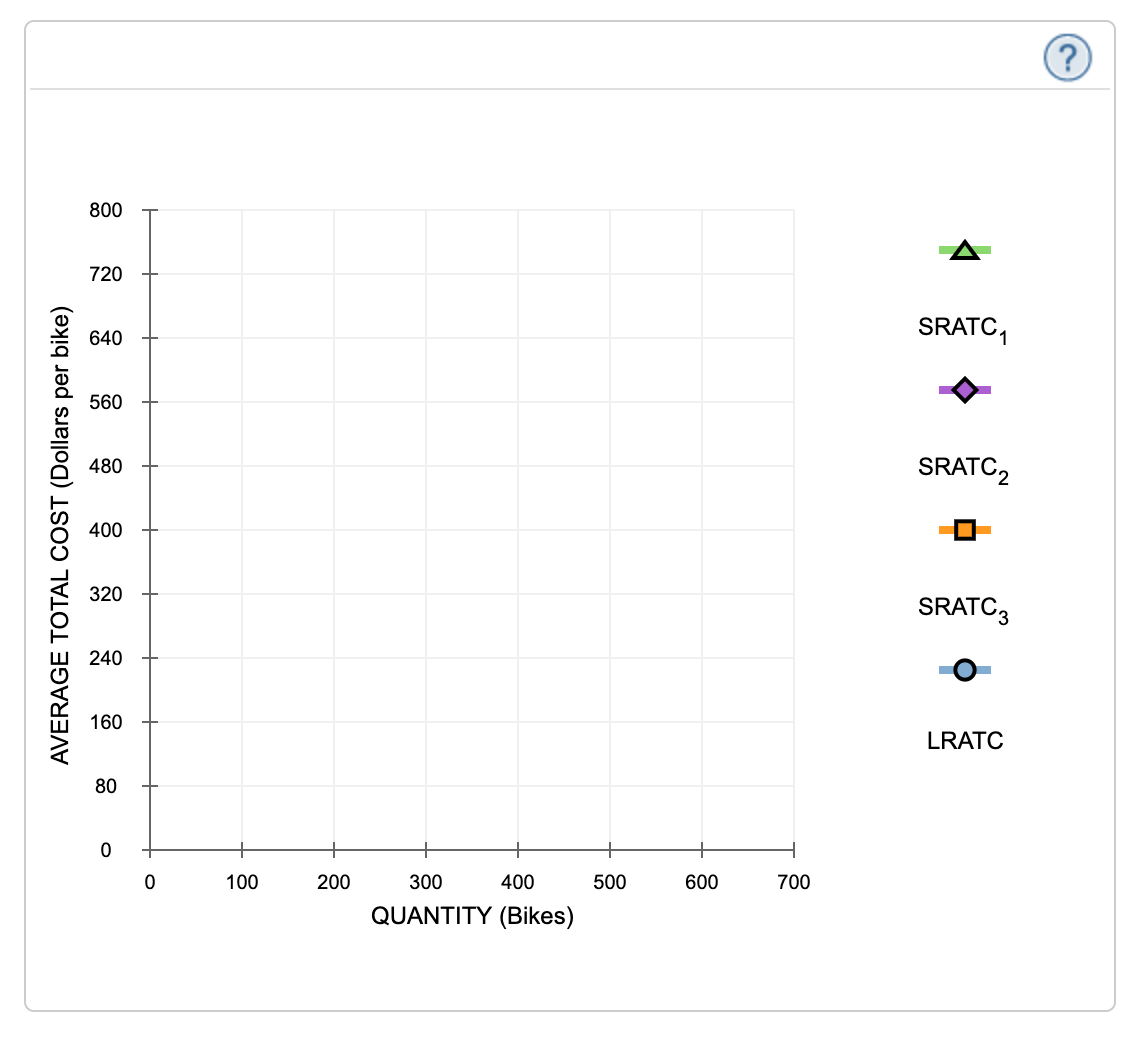Average Total Cost (Dollars per bike) Number of Factories = 100 = 200 = 300 = 400 = 500 = 600 440 280 240 320 480 800 2 620 380 240 240 380 620 3 800 480 320 240 280 440 800 720 SRATC, 640 560 480 SRATC, 400 320 SRATC3 240 160 LRATC 80 100 200 300 400 500 600 700 QUANTITY (Bikes) AVERAGE TOTAL COST (Dollars per bike) ~)
Average Total Cost (Dollars per bike) Number of Factories = 100 = 200 = 300 = 400 = 500 = 600 440 280 240 320 480 800 2 620 380 240 240 380 620 3 800 480 320 240 280 440 800 720 SRATC, 640 560 480 SRATC, 400 320 SRATC3 240 160 LRATC 80 100 200 300 400 500 600 700 QUANTITY (Bikes) AVERAGE TOTAL COST (Dollars per bike) ~)
Chapter8: Production And Costs
Section8.4: Costs Of Production: Total, Average, Marginal
Problem 1ST
Related questions
Question
5. Costs in the short run versus in the long run
Ike’s Bikes is a major manufacturer of bicycles. Currently, the company produces bikes using only one factory. However, it is considering expanding production to two or even three factories. The following table shows the company’s short-run average total cost (SRATC) each month for various levels of production if it uses one, two, or three factories. (Note: Q equals the total quantity of bikes produced by all factories.)
IMG 1
Suppose Ike’s Bikes is currently producing 600 bikes per month in its only factory. Its short-run average total cost is _________ per bike.
Suppose Ike’s Bikes is expecting to produce 600 bikes per month for several years. In this case, in the long run, it would choose to produce bikes using ___________. (One, two, or three factories)
On the following graph, plot the three SRATC curves for Ike’s Bikes from the previous table. Specifically, use the green points (triangle symbol) to plot its SRATC curve if it operates one factory (SRATC1); use the purple points (diamond symbol) to plot its SRATC curve if it operates two factories (SRATC2); and use the orange points (square symbol) to plot its SRATC curve if it operates three factories (SRATC3). Finally, plot the long-run average total cost (LRATC) curve for Ike’s Bikes using the blue points (circle symbol).
Note: Plot your points in the order in which you would like them connected. Line segments will connect the points automatically.
IMG 2
In the following table, indicate whether the long-run average cost curve exhibits economies of scale, constant returns to scale, or diseconomies of scale for each range of bike production.
|
Range
|
Economies of Scale
|
Constant Returns to Scale
|
Diseconomies of Scale
|
|
|---|---|---|---|---|
| Fewer than 300 bikes per month |
|
|
|
|
| Between 300 and 400 bikes per month |
|
|
|
|
| More than 400 bikes per month |
|
|
|

Transcribed Image Text:Average Total Cost
(Dollars per bike)
Number of Factories
= 100
= 200
= 300
= 400
= 500
= 600
440
280
240
320
480
800
2
620
380
240
240
380
620
3
800
480
320
240
280
440

Transcribed Image Text:800
720
SRATC,
640
560
480
SRATC,
400
320
SRATC3
240
160
LRATC
80
100
200
300
400
500
600
700
QUANTITY (Bikes)
AVERAGE TOTAL COST (Dollars per bike)
~)
Expert Solution
This question has been solved!
Explore an expertly crafted, step-by-step solution for a thorough understanding of key concepts.
This is a popular solution!
Trending now
This is a popular solution!
Step by step
Solved in 3 steps with 3 images

Knowledge Booster
Learn more about
Need a deep-dive on the concept behind this application? Look no further. Learn more about this topic, economics and related others by exploring similar questions and additional content below.Recommended textbooks for you


Economics (MindTap Course List)
Economics
ISBN:
9781337617383
Author:
Roger A. Arnold
Publisher:
Cengage Learning

Managerial Economics: A Problem Solving Approach
Economics
ISBN:
9781337106665
Author:
Luke M. Froeb, Brian T. McCann, Michael R. Ward, Mike Shor
Publisher:
Cengage Learning


Economics (MindTap Course List)
Economics
ISBN:
9781337617383
Author:
Roger A. Arnold
Publisher:
Cengage Learning

Managerial Economics: A Problem Solving Approach
Economics
ISBN:
9781337106665
Author:
Luke M. Froeb, Brian T. McCann, Michael R. Ward, Mike Shor
Publisher:
Cengage Learning

Economics Today and Tomorrow, Student Edition
Economics
ISBN:
9780078747663
Author:
McGraw-Hill
Publisher:
Glencoe/McGraw-Hill School Pub Co